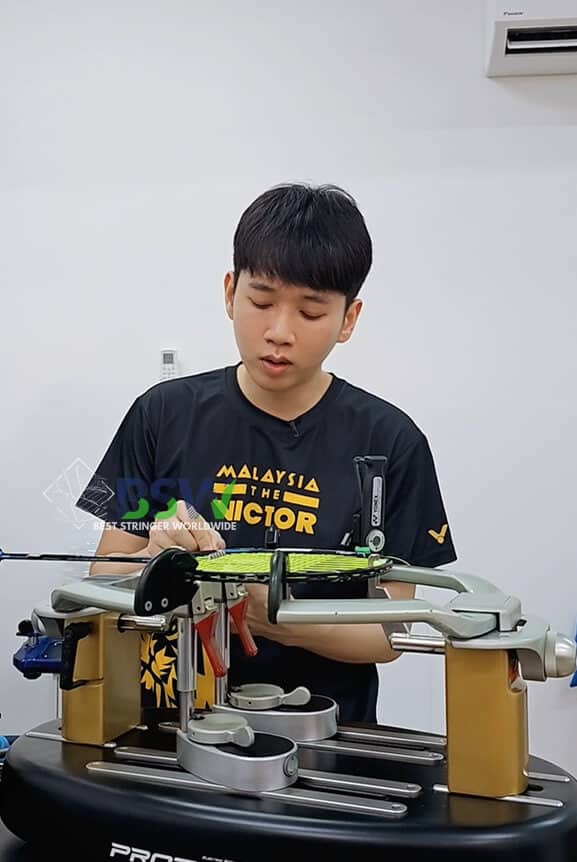Are you curious about how different badminton racquet frame shapes affect your game? At Best Stringer Worldwide (BSW), we’re committed to helping stringers and players improve their skills and knowledge. In this comprehensive guide, we’ll dive deep into the world of badminton racquet frame shapes, exploring their characteristics, advantages, and how they influence your performance on the court.
Badminton Racquet Frame Shape Simulator
The Importance of Racquet Frame Shapes
Before we delve into the specifics, let’s test your current knowledge with a quick quiz:
Badminton Racquet Frame Shape Quiz
Understanding racquet frame shapes is crucial for both players and stringers. As a stringer, your expertise in this area can significantly enhance your ability to serve your customers and provide tailored recommendations. For players, choosing the right frame shape can make a substantial difference in your performance and enjoyment of the game.
Common Badminton Racquet Frame Shapes
Let's explore the most common badminton racquet frame shapes and their characteristics:
- Oval Shape
- Traditional design
- Balanced performance
- Suitable for all-around players
- Isometric Shape
- Larger sweet spot
- Increased power on off-center hits
- Popular among beginners and intermediate players
- Diamond Shape
- Aerodynamic design
- Faster swing speed
- Favored by advanced players for quick attacks
- Teardrop Shape
- Combines elements of oval and isometric shapes
- Good balance of power and control
- Versatile option for various playing styles
| Shape | Power | Control | Sweet Spot | Best For |
|---|---|---|---|---|
| Oval | Medium | High | Medium | All-around players |
| Isometric | High | Medium | Large | Beginners, Intermediate |
| Diamond | High | Low | Small | Advanced attackers |
| Teardrop | Very High | Low | Medium | Power hitters |
How Frame Shapes Affect Performance
The shape of a badminton racquet frame influences several aspects of your game:
- Sweet Spot Size: The sweet spot is the optimal hitting area on the racquet face. Isometric shapes typically offer larger sweet spots, providing more forgiveness on off-center hits.
- Power Generation: Some shapes, like the teardrop, are designed to maximize power output. This can be particularly beneficial for players who rely on powerful smashes.
- Control: Oval shapes often provide better control due to their traditional design and weight distribution.
- Maneuverability: Diamond-shaped frames are known for their excellent maneuverability, allowing for quick shots and defensive play.
- Air Resistance: Aerodynamic shapes like the diamond can reduce air resistance, enabling faster swing speeds.
Understanding these factors is essential for stringers offering badminton stringing courses or racquet stringing courses. By incorporating this knowledge into your training, you can provide more comprehensive advice to your clients and enhance your badminton stringing certification program.
Choosing the Right Frame Shape for Your Style
Selecting the ideal racquet frame shape depends on various factors:
- Playing Style: Are you an aggressive attacker or a defensive player? Power hitters might prefer teardrop or isometric shapes, while defensive players could benefit from oval or diamond shapes.
- Skill Level: Beginners often find isometric shapes more forgiving, while advanced players might opt for more specialized shapes like diamond or teardrop.
- Physical Attributes: Your strength, height, and reach can influence which shape works best for you.
- Personal Preference: Ultimately, comfort and feel are crucial. Experiment with different shapes to find what suits you best.
As a stringer, understanding these factors will help you guide your customers to the right choice, enhancing their satisfaction and potentially increasing repeat business.

The Role of Stringing in Frame Shape Performance
While frame shape is important, proper stringing is equally crucial in maximizing a racquet's performance. Here are some key points to consider:
- String Tension: Different frame shapes may benefit from varying string tensions. For example, isometric shapes might allow for higher tensions without sacrificing too much power.
- String Pattern: The string bed density can complement or counteract the frame shape's characteristics. A denser pattern on a power-oriented shape can add control, while a more open pattern on a control-oriented shape can increase power.
- String Type: The choice of string material and gauge can further enhance the frame shape's properties. Thinner strings (higher gauge) generally provide more power and spin, while thicker strings offer more durability and control.
- Weather Considerations: As noted in our Chinese reference material, weather can affect string performance. Nylon and polyester strings are sensitive to temperature, becoming more brittle in cold, dry conditions. During winter, consider using slightly thicker strings to compensate for this effect.
By mastering these aspects, you'll be better equipped to offer high-quality badminton stringing courses and racquet stringing courses, setting yourself apart in the industry.
The Importance of Data in Stringing
As a professional stringer, maintaining a database of your clients' stringing history is invaluable. This practice, recommended in our Chinese source material, allows you to:
- Track string and tension preferences
- Monitor racquet condition (e.g., grommets, grip)
- Suggest timely restrings or racquet maintenance
- Adjust recommendations based on past experiences
Implementing this system can significantly enhance your service quality and build customer loyalty. It's an essential skill to include in any comprehensive badminton stringing certification program.
Continuous Learning and Improvement
The world of badminton equipment is constantly evolving. To stay at the top of your game as a stringer, consider the following:
- Stay Informed: Keep up with the latest racquet technologies and stringing techniques.
- Attend Workshops: Participate in badminton stringing courses to refine your skills.
- Seek Certification: Pursue a badminton stringing certification to validate your expertise.
- Engage with Players: Regularly communicate with players to understand their needs and preferences.
By committing to ongoing education, you'll be better equipped to serve your clients and adapt to new trends in racquet design and stringing technology.
Conclusion
Understanding badminton racquet frame shapes is crucial for both players and stringers. By mastering this knowledge, stringers can provide more valuable services to their clients, while players can make informed decisions about their equipment.
Remember, the perfect racquet is a combination of the right frame shape, appropriate stringing, and a good match to the player's style. As a stringer, your expertise in these areas can significantly impact a player's performance and enjoyment of the game.
At Best Stringer Worldwide (BSW), we're dedicated to helping stringers and players improve their skills and knowledge. Whether you're looking to enhance your stringing techniques or choose the perfect racquet, we're here to support your badminton journey.
(Quiz Answer: B) Isometric shapes are typically associated with increased power due to their larger sweet spot and improved performance on off-center hits.)
Badminton Racquet Shape Recommender
This comprehensive guide on badminton racquet frame shapes is brought to you by Best Stringer Worldwide (BSW), your trusted source for badminton stringing courses, racquet stringing courses, and badminton stringing certification. Our mission is to empower stringers and players with the knowledge and skills they need to excel in the world of badminton.

About Best Stringer Worldwide
Best Stringer Worldwide is a comprehensive badminton and tennis stringing education program. We provide in-depth training on stringing techniques, racquet technology, and player-specific customization. Our curriculum is designed to help stringers understand and meet the needs of all badminton players, from casual enthusiasts to competitive athletes.
Read More